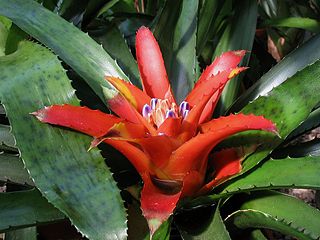Related Research Articles

The genus Tacca, which includes the batflowers and arrowroot, consists of flowering plants in the order Dioscoreales, native to tropical regions of South America, Africa, Australia, Southeast Asia, and various oceanic islands. In older texts, the genus was treated in its own family Taccaceae, but the 2003 APG II system incorporates it into the family Dioscoreaceae. The APG III and APG IV systems continue to include Tacca in Dioscoreaceae.

Nidularium fulgens is a plant species in the genus Nidularium. This species is endemic to Brazil.

Nidularium innocentii is a species of bromeliad in the genus Nidularium.

Tacca chantrieri is a species of flowering plant in the yam family Dioscoreaceae. It is commonly called the black bat flower.

Taccalonolides are a class of microtubule-stabilizing agents isolated from Tacca chantrieri that has been shown to have selective cancer-fighting properties. Other examples of microtubule-stabilizing agents include taxanes and epothilones, both of which prevent cancer cells from dividing by interfering with tubulin. While taxanes like Paclitaxel and docetaxel have been used successfully against breast, ovarian, prostate, and non–small-cell lung cancers, intrinsic and acquired drug resistance limit their anticancer properties. Unlike taxanes, taccalonolides appear to work through a different mechanism of action that does not involve tubulin, although recently isolated taccalonolides AF and AJ have shown tubulin-interaction activity. The discovery of taccalonolides opens up new possibilities to treat cancer cells, especially ones that are taxane or epithilone resistant.

The Williams Conservatory is located in Laramie, Wyoming at campus of the University of Wyoming. It opened in 1994. The main greenhouse is filled with exotic plants from various climates and biomes. The Conservatory is open daily for public and it receives hundreds of visitors each year.